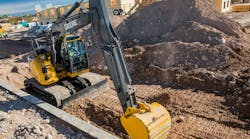Mike Vorster’s article suggesting fleets create a Fluids Czar within the equipment-management organization has struck a chord. Fleet professionals agree that fluid management has become more than a part-time responsibility.
Tier 4-Final machines that incorporate Selective Catalyic Reduction technology use Diesel Exhaust Fluid, a urea-based fluid that requires fleets to consider how to store, dispense, filter and source another fluid in the fleet. A new engine lubricant is being developed, too, which will be backward compatible and applicable to any engine regardless of the emission standards it attains.
This idea of a fluid czar resonates with fleet managers when the discussion turns to fuel management. Three years ago, editor Walt Moore wrote about how critical clean fuel would be in the diesel engines developed to meet emissions standards. It’s worth repeating what Philip Johnson, Donaldson Filtrations Solutions, said:
“Total machining clearance for a typical fuel injector in a common-rail fuel system today might be just two microns—about the thickness of a single cell of bacteria. Tighter tolerances are needed, because injection pressures are increasing in order to more precisely control combustion. Ten or 15 years ago, pressures were 7,000 to 10,000 psi; today, pressures of 30,000 psi are routine and may be as high as 60,000 psi in the future.”
Filtration suppliers understand this. It may be that fuel suppliers do not. Leigh Dennis, CEM, Carolina Sunrock, installed filtration on its bulk tanks that filtered outgoing fuel to 4 microns. He reports repeated clogging of filters at the pumps.
Dennis also told me that he had to explain to his fuel supplier how Tier 4 technology worked. The information contained in the paragraph above was new information, and the supplier “had no idea the [machines’] on-board filters filtered down to 2 microns.”
Fleet managers must make an immediate and specific push for clean fuel:
- Test your fuel to ensure that clean diesel is going into your emissions-controlling engines.
- Ensure that your in-house fuel supply, from delivery to fuel pump, has the proper filtration.
- Ask your fuel supplier if it meets cleanliness standards for diesel fuel. Dennis refers to ISO 14/13/11.
Dennis suggests this question be asked of every fuel supplier: “If our fuel supplier arrives to deliver fuel to our tanks and it will not pass through the filters, what then?” He says he has yet to get a straight answer.
More fleets need to ask the question.





